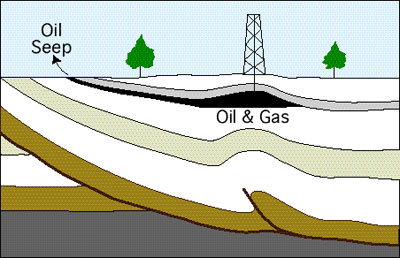Pacific Coastal and Marine Science Center
Natural Oil & Gas Seeps in California
Oil and gas seeps are natural springs where liquid and gaseous hydrocarbons (hydrogen-carbon compounds) leak out of the ground. Whereas freshwater springs are fed by underground pools of water, oil and gas seeps are fed by natural underground accumulations of oil and natural gas.
 At right, the schematic shows a vertical slice through the Earth's crust, with folded layers of sedimentary rocks holding oil and gas in the crest of an underground fold. Sometimes oil leaks out of the fold and forms a natural oil seep at the land surface.
At right, the schematic shows a vertical slice through the Earth's crust, with folded layers of sedimentary rocks holding oil and gas in the crest of an underground fold. Sometimes oil leaks out of the fold and forms a natural oil seep at the land surface.
 Oil that leaks to the Earth's surface is eventually transformed from a clear fluid to a tar-like substance called asphaltum. The lighter components of the oil are lost to evaporation, and the remaining heavier oil is oxidized and degraded by bacteria until it becomes sticky and black. In this photo at right, asphaltum from a cliff-side seep near Santa Barbara, California, forms a hard, rolling surface that looks like old, worn pavement. Asphaltum from this and similar seeps may have been collected by the Chumash Indians to caulk their canoes.
Oil that leaks to the Earth's surface is eventually transformed from a clear fluid to a tar-like substance called asphaltum. The lighter components of the oil are lost to evaporation, and the remaining heavier oil is oxidized and degraded by bacteria until it becomes sticky and black. In this photo at right, asphaltum from a cliff-side seep near Santa Barbara, California, forms a hard, rolling surface that looks like old, worn pavement. Asphaltum from this and similar seeps may have been collected by the Chumash Indians to caulk their canoes.
Photo by I. Priestaf. From Onshore Oil and Gas Seeps in California.